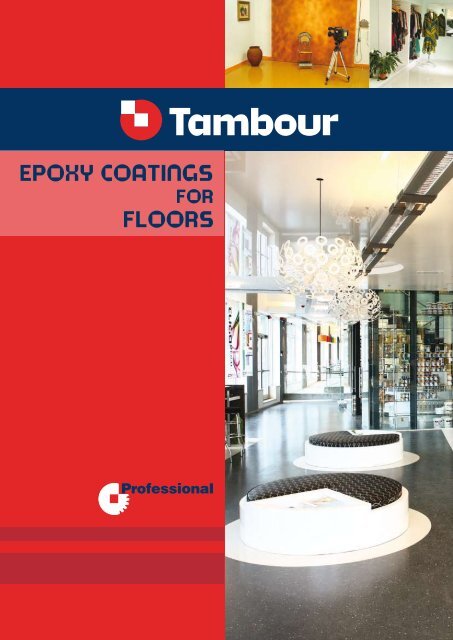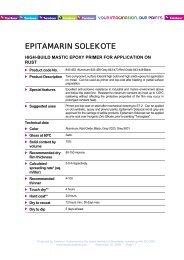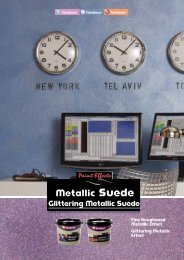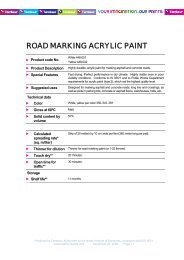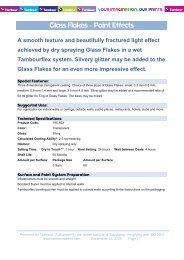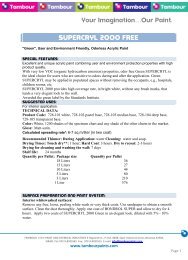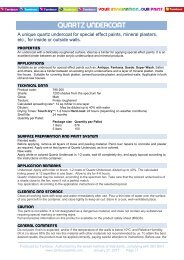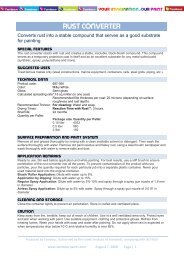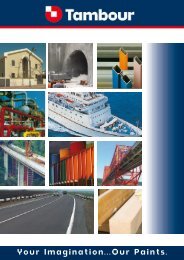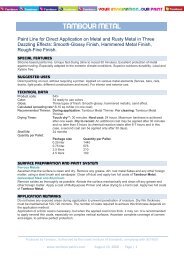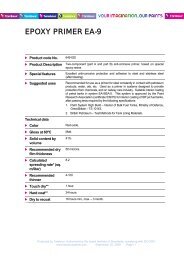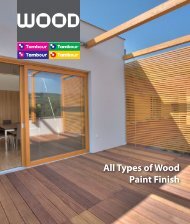EPOXY COATINGS FLOORS - Tambour Paints
EPOXY COATINGS FLOORS - Tambour Paints
EPOXY COATINGS FLOORS - Tambour Paints
You also want an ePaper? Increase the reach of your titles
YUMPU automatically turns print PDFs into web optimized ePapers that Google loves.
<strong>EPOXY</strong> <strong>COATINGS</strong><br />
FOR<br />
<strong>FLOORS</strong>
INTRODUCTION<br />
FLOOR PAINTS – GENERAL SUMMARY OF SYSTEMS<br />
This booklet<br />
contains general<br />
guidance<br />
for selecting<br />
the most suitable<br />
system, according<br />
to your<br />
requirements.<br />
TABLE OF CONTENT<br />
Epoxy coatings for floors - Our coating are designed for substrate<br />
with heavy mechanical equipment, and heavy loading conditions. Our leading<br />
products- Epicatalac SL, Tamafloor TR, Polyurea (polyaspartite) use<br />
100% solid epoxy coatings that will give you one of the hardest coatings<br />
available, with low V.O.C.<br />
Please select the recommended system with our FLOOR PAINTS – GENERAL<br />
SUMMARY OF SYSTEMS. You can search in the table according to the description<br />
of the specific project that you intend to carry out, or a similar one (kitchens,<br />
warehouses, garages, etc.). The bottom of the table shows a legend describing<br />
the 3 levels (in ascending order) that refer to the following parameters: level of<br />
load or wear of the coatings, chemical resistance and appearance.<br />
For example:<br />
If you wish to paint a warehouse that employs forklifts (load level 3) and the<br />
surface will be exposed to leakage of oils and fuel (chemical resistance, level<br />
2), and the general appearance after painting should be uniform and smooth<br />
(general appearance level 3), then the system recommended by the table will<br />
be C2. This means that according to the table, you should refer to page 12,<br />
which describes system C2.<br />
After receiving initial guidance from the table, you can obtain<br />
technical sheets of the relevant products from our Internet site at<br />
www.tambourpaints.com or by calling one of our sales representatives.<br />
With best wishes,<br />
The International Marketing Team<br />
FLOOR PAINTS – GENERAL SUMMARY OF SYSTEMS 3<br />
PREPARATION OF SURFACE 4<br />
A1 PAINT SYSTEM FOR IMPREGNATION 5<br />
B1 BASIC <strong>EPOXY</strong> PAINT SYSTEM 6<br />
B2 BASE SYSTEM OF POLYURETHANE <strong>EPOXY</strong> PAINT 7<br />
B3 POLYURETHANE <strong>EPOXY</strong> PAINT SYSTEM 8<br />
B4 POLYUREA (POLYASPARTITE) SYSTEM IN THIN LAYER 9<br />
C1 LOW-THICKNESS POURED <strong>EPOXY</strong> COATING 10<br />
C2 HIGH-THICKNESS (1.2-3 mm) <strong>EPOXY</strong> <strong>COATINGS</strong> 11<br />
C3 COLORED QUARTZ <strong>EPOXY</strong> COATING IN CASTING SYSTEM 12<br />
C4 TAMAFLEX 13<br />
Principal infrastructure<br />
characteristics<br />
Recommended systems<br />
Load Chemical General Impreg- Low-thickness Non-diluted<br />
Load:<br />
1. Heavy foot traffic<br />
2. Delivery carts, vehicles in garages or parking bays<br />
3. Vehicles and fork lifts, loading areas<br />
Resistance to chemicals:<br />
1. Water, detergents (cleaning materials)<br />
2. Oils, fuels and detergents (typical of garages)<br />
3. Skydrol oils, weak acids, bases<br />
resistance appear- nation paint system multilayer<br />
after painting ance coatings<br />
Light industry 2 2 2 √√ √√ √√<br />
General appearance after painting:<br />
1. General appearance of the concrete before painting (depressions, pitting, unevenness).<br />
2. No holes or pitting is apparent, but the original appearance of the concrete can still be seen.<br />
3. Uniform and smoot appearance (Slopes in the concrete are still visible.)<br />
A1 B1 B2 B3 B4 B5 C1 C2 C3 D1<br />
production floor 2 2 3 √√√√ √√√√<br />
Chemical, 3 3 3 √√√ √√√√ √√√√<br />
heavy industry<br />
production Floor<br />
Aircraft hangars 3 3 3 √√√√<br />
Garages 2 2 1 √√ √√ √√<br />
2 2 3 √√√ √√√√ √√√√ √√√√<br />
Parking lots and 2 2 3 √√√ √√√√ √√√√ √√√√<br />
entrances/exits<br />
Parking lots and 1 2 1 √ √√ √√ √√<br />
parking bays 1 2 3 √√√√<br />
Treatment for 1 2 2 √√√ √√√ √√√√ √√√√<br />
slippery surfaces<br />
used by<br />
pedestrians<br />
Warehouses 1 1 1 √ √√ √√ √√<br />
and packing 2 2 2 √√ √√ √√ √√√<br />
houses 3 2 3 √√√√ √√√√<br />
Laboratories 1 2 2 √√ √√ √√√<br />
1 3 3 √√√√ √√√√<br />
Offices and 1 1 2 √ √√ √√ √√ √√ √√ √√<br />
showrooms 1 1 3 √√√√ √√√√<br />
VARIOUS EFFECTS IN FLOOR <strong>COATINGS</strong> 15<br />
Elementary, prevention of the appearance of dust from wear of the concrete<br />
Limited resistance to loads and chemicals; pitting still seen and concrete surface uneven<br />
Good quality, very good resistance to chemicals and wear, smooth finish<br />
Excellent quality, highest resistant to wear and chemicals, smooth finish<br />
2 3
PREPARATION OF SURFACE<br />
A1 PAINT SYSTEM FOR IMPREGNATION<br />
INTRODUCTION<br />
The ability of epoxy paint to stick to concrete depends, among other things, on how well the concrete surface<br />
is prepared in advance.<br />
The adhesibility of epoxy to concrete is in general higher than the cohesive strength of the concrete itself.<br />
Below are several “rules of thumb” about preparing the surface. The recommendations do not replace the<br />
technical specification or the required standards, but are intended solely for preliminary general orientation<br />
and estimates. In addition, for each project, you should obtain professional guidance from the technical<br />
department.<br />
SURFACE PREPARATION – GENERAL<br />
Contaminants and oils should be removed from the surface of the concrete by using detergents or mechanical<br />
means (such as shot blast, diamond grinder and etc.) in order to obtain a completely clean surface. If detergents<br />
are used, rinse the concrete with mains water until a neutral PH value of the surface is obtained, and then<br />
leave the surface to dry.<br />
If the concrete surface is particularly rough, or if it intended to produce new slopes, it is possible to level the<br />
surface using an EX spirit level. For C2 and C3 systems, 700 Microns should be removed (water cement).<br />
The concrete is ready for painting after being cured for 28 days and exhibiting a maximum moisture content<br />
of 4% (depending on the product).<br />
GENERAL TABLE SHOWING THE REQUIRED ROUGHNESS LEVEL<br />
OF THE SURFACE BEFORE PAINTING<br />
The paint system for impregnation is intended for painting concrete surfaces in order to prevent the creation<br />
of dust (derived from abrasion of the concrete). The painting “photographs” the image of the concrete and<br />
gives it a “wet” appearance.<br />
RECOMMENDED SYSTEM<br />
Position in Designation General Recommended Gloss Shade Remarks<br />
the system description dry thickness<br />
Base Epicatalac Polyamine 30 Glossy Clear Slight<br />
epoxy base<br />
Intermediate – – – – – –<br />
yellowness<br />
with time<br />
Top Epicatalac Polyamine 30 Glossy Clear Slight<br />
epoxy base<br />
yellowness<br />
with time<br />
Type of infrastructure Description of preparation for a Description of preparation for a 1-4<br />
“thin” paint system of up to 300 mm thick poured epoxy coating<br />
microns<br />
B-Concrete 300<br />
Polishing the surface with a polishing Milling the surface by means of a<br />
machine until the original appearance milling machine or by a shot blast<br />
of the surface is blurred, to a machine to a roughness depth of at<br />
roughness depth of at least 200 least 1 mm.<br />
microns. Apply a base coat as per (It is possible to roughen by means<br />
specifications.<br />
of similar mechanical devices.)<br />
“Helicopter” processed As above As above<br />
concrete<br />
A “Corodor” or epoxy floor As above<br />
As above<br />
reinforced with metal beads<br />
“Terracio” floors Diamond polishing for removing the As above<br />
glazing from tiles to a roughness Check that the interspaces are<br />
depth of 200 micron. Check that the clean and filled up.<br />
interspaces are clean and filled up.<br />
Apply a base coat as per<br />
specifications.<br />
Repainting a floor that Polishing the surface with a polishing Milling the surface with a milling<br />
has an old epoxy coating machine until the original appearance machine or a shot blasting machine<br />
of the surface is blurred, to a to a depth of at least 1 mm.<br />
roughness depth of 50-100 micron. (It is possible to roughen the<br />
Apply a base coat as per<br />
surface using similar mechanical<br />
specifications.<br />
devices).<br />
Tamaglass for heavy coating - for details please see system B1 to B4<br />
4 5
B1 BASIC <strong>EPOXY</strong> PAINT SYSTEM<br />
B2 BASE SYSTEM OF POLYURETHANE <strong>EPOXY</strong> PAINT<br />
PAINT SYSTEM FOR PAINTING THE CONCRETE BASE FOR WALLS OR <strong>FLOORS</strong><br />
– 110 MICRONS<br />
Excellent resistance to detergents and lubricants.<br />
Suitable for painting warehouses, parking bays, garages and maintenance floors in light industrial plants.<br />
The painting “photographs” the structure of the original surface that includes holes, pitting, projections and<br />
unevenness.<br />
RECOMMENDED SYSTEM<br />
PAINT SYSTEM OF DIFFERENT SHADES FOR PAINTING CONCRETE INFRASTRUCTURE OF<br />
WALLS OR <strong>FLOORS</strong> – 110 MICRON<br />
The system is flexible and easily maintainable.<br />
Has excellent resistance to detergents and lubricants; is relatively easy to clean and produces an elegant<br />
silky finish.<br />
Suitable for painting warehouses, parking bays, garages, maintenance floors in light industrial plants, and<br />
intended for low loads; suitable for outdoor use. The painting “photographs” the original surface, including<br />
holes, pitting, projections and unevenness.<br />
RECOMMENDED SYSTEM<br />
Position in Designation General Recommended Gloss Shade Remarks<br />
the system<br />
description dry thickness<br />
Base Epictalc Polyamine 50 Glossy Clear Pitting can be smoothed<br />
epoxy<br />
out with Epictalc SL in<br />
base<br />
a sand mixture.<br />
Intermediate Epoxy EA4 Polyamine 50 Glossy Gray Additional shades as<br />
epoxy red required (depending on<br />
quantity). An anti-slipping<br />
effect can be obtained by<br />
spreading granules.<br />
Top Epoxy E4 Polyamine 50 Glossy Gray red Additional shades as<br />
epoxy<br />
required (depending on<br />
quantity). An anti-slipping<br />
effect can be obtained by<br />
spreading granules<br />
Position in Designation General Recommended Gloss Shade Remarks<br />
the system description dry thickness<br />
Base Epictalc Polyamine 30 Glossy Clear Tamglass should be<br />
epoxy base<br />
applied on top of the<br />
Epitalc when the latter<br />
is still sticky.<br />
Intermediate Tamglass Polyurethane 50 Silky RAL The anti-slipping effect<br />
top<br />
shades can be attained by<br />
spreading granules.<br />
Top Tamglass Polyurethane 50 Silky RAL shades<br />
top<br />
PRINCIPAL PROPERTIES<br />
PRINCIPAL PROPERTIES<br />
Property Degree of suitability Remarks<br />
Wear and load resistance + Suitable for heavy foot traffic and delivery carts<br />
with rubber wheels<br />
Resistance to chemicals + Excellent resistance to detergents and cleaning<br />
materials<br />
Resistance to lubricants ++ Suitable for painting garage floors<br />
Property Degree of Remarks<br />
suitability<br />
Wear and + Suitable for heavy foot traffic and delivery carts (with rubber wheels). It<br />
load<br />
is advisable to apply two layers of Epoxy EA4 of the same shade. In this<br />
resistance<br />
way, if the top layer wears out, the exposed bottom layer will be of the<br />
same shade.<br />
Resistance to + Excellent resistance to detergents and cleaning materials<br />
chemicals<br />
Resistance to ++ Suitable for painting hangars. Resistant to Skydrol aviation hydraulic fuel.<br />
lubricants<br />
+ - Limited resistance<br />
++ - Good resistance<br />
+++ - Very good resistance<br />
++++ - Excellent resistance<br />
+ - Limited resistance<br />
++ - Good resistance<br />
+++ - Very good resistance<br />
++++ - Excellent resistance<br />
Tamaglass Coating Before<br />
After<br />
6 7
B3 POLYURETHANE <strong>EPOXY</strong> PAINT SYSTEM<br />
B4 POLYUREA (POLYASPARTITE) SYSTEM IN THIN LAYER<br />
PAINT SYSTEM FOR PAINTING CONCRETE INFRASTRUCTURE FOR WALLS OR <strong>FLOORS</strong> –<br />
280 MICRON<br />
Excellent resistance to detergents and lubricants.<br />
Suitable for painting warehouses, parking bays, garages and maintenance floors in light industrial plants. The<br />
system is based on maintenance paints. This system has a longer service life than system B2, because of its<br />
increased thickness.<br />
RECOMMENDED SYSTEM<br />
POLYASPARTITE CONSISTS OF POLYUREA MODIFIED FOR THIN-LAYER APPLICATION<br />
Resistant to UV radiation and suitable for exposure outdoors<br />
Rapid solidification<br />
Flexibility (extension of up to 250%) but still resistant to wear and mechanical damage<br />
Usually spray applied; brush and roller application possible<br />
Good adhesion to various backgrounds, including marble, ceramics and glass<br />
Also available as a transparent product for wood protection and as a transparent top layer over a<br />
poured epoxy layer<br />
Position in the Designation General Recommended Gloss Shade Remarks<br />
system description dry thickness<br />
Base Epictalc Polyamine 30 Glossy Clear<br />
epoxy base<br />
Intermediate Multipoxy or Polyamide 200 Silky RAL When worked with<br />
Polychemcor epoxy<br />
a roller, the finish is<br />
Multi-thickness<br />
like an orange peel.<br />
and firm layer<br />
At this stage, it is<br />
possible to spread<br />
granules to prevent<br />
slipping.<br />
Top Tamglass Polyurethane 50 Silky RAL Improves washability<br />
top shades and wear resistance<br />
PRINCIPAL PROPERTIES<br />
Property Degree of Remarks<br />
suitability<br />
Wear and ++ It is advisable to apply Multipoxy and Tamglass of the same shade. In<br />
load<br />
this way, if the top layer wears out, the bottom layer that will be exposed<br />
resistance<br />
will be of the same shade. The thickness of the intermediate layers<br />
provides an additional period of wear protection (compared with system 1)<br />
Resistance to + Excellent resistance to detergents and cleaning materials<br />
chemicals<br />
Resistance to ++<br />
lubricants<br />
RECOMMENDED SYSTEM<br />
Recommended Designation General Recommended Gloss Shade Remarks<br />
system description dry thickness<br />
(dry microns)<br />
Option A: Polyaspartate Two-component 150-300 Glossy Transparent In special cases,<br />
Single layered base and top RAL shades a different base<br />
base and top for concrete should be applied<br />
surfaces<br />
to pre seal the<br />
concrete in order<br />
to prevent release<br />
of gases trapped<br />
in the concrete.<br />
Option B: Base Transparent 150 Glossy Transparent<br />
Anti-slip Polyaspartate or varied<br />
system using<br />
shades<br />
colored Granules in a Spreading Uniform Various Also suitable<br />
granules variety of colored spreading shades for wood surfaces<br />
shades, which granules on<br />
for indoor and<br />
are visible the base, outdoor use<br />
through the while it is<br />
top layer still wet<br />
Top Transparent 150 Glossy Transparent<br />
Polyaspartate<br />
PRINCIPAL PROPERTIES<br />
Property<br />
Wear resistance of a single thin layer +++<br />
Degree of suitability Remarks<br />
Resistance to chemicals ++ See table of resistances<br />
Resistance to lubricants +++ See table of resistances<br />
Flexibility ++++ Up to 200% extension!<br />
+ - Limited resistance<br />
++ - Good resistance<br />
+++ - Very good resistance<br />
++++ - Excellent resistance<br />
Tamafloor System Application<br />
+ - Limited resistance<br />
++ - Good resistance<br />
+++ - Very good resistance<br />
++++ - Excellent resistance<br />
8 9
C1 LOW-THICKNESS POURED <strong>EPOXY</strong> COATING<br />
C2 HIGH-THICKNESS (1.2-3 mm) <strong>EPOXY</strong> <strong>COATINGS</strong><br />
ECONOMIC PAINT SYSTEM FOR PAINTING CONCRETE INFRASTRUCTURE – 700 MICRON<br />
Excellent resistance to detergents and lubricants.<br />
Suitable for painting warehouses, garages, maintenance floors in light industrial plants and parking lots.<br />
When poured in low thicknesses, the paint distribution is not uniform. The resulting finish has the texture of a<br />
fine orange peel.<br />
POURABLE <strong>EPOXY</strong> <strong>COATINGS</strong> FOR CASTING CONCRETE <strong>FLOORS</strong><br />
Excellent pourability, allowing complete covering of pitting and of unevenness in the concrete. Excellent<br />
resistance to detergents and lubricants.<br />
Suitable for floors of warehouses, parking lots, garages, epoxy floors in light and heavy industrial plants.<br />
Capable of bearing loads typical of equipment in machinery rooms.<br />
RECOMMENDED SYSTEM<br />
RECOMMENDED SYSTEM<br />
Position in the Designation General Recommended Gloss Shade Remarks<br />
system<br />
description dry thickness<br />
Base Epictalc SL Polyamine 150 Glossy RAL Shading by using an additive<br />
epoxy<br />
shades or by coloring the product<br />
Top Templor TR Pourable 500 Glossy RAL Shading by using an additive<br />
polyamine<br />
shades or by coloring the product,<br />
epoxy<br />
which allows coating at this<br />
thickness<br />
PRINCIPAL PROPERTIES<br />
Position in the Designation General Recommended Gloss Shade Remarks<br />
system description dry thickness<br />
Base Epictalc SL or Pourable 300 Glossy RAL Epitalc has an<br />
Templor TR polyamine shades advantage on corrosive<br />
epoxy<br />
surfaces<br />
Intermediate Templor TR Pourable *900-2500 Glossy RAL A glittering effect can be<br />
polyamine<br />
shades obtained by spreading<br />
epoxy<br />
unique powders.<br />
Top Tamglass (not Polyurethane 50 Silky RAL Recommended for<br />
mandatory) top shades application to hangar<br />
floors<br />
PRINCIPAL PROPERTIES<br />
Property Degree of suitability Remarks<br />
Wear resistance of a single +++<br />
Suitable for travel of vehicles and fork lifts<br />
thin layer<br />
and positioning of machinery<br />
Resistance to chemicals<br />
Resistance to lubricants ++++<br />
Property<br />
Degree of suitability Remarks<br />
Wear and load resistance ++++ Suitable for travel of vehicles and fork lifts<br />
and positioning of machinery<br />
Resistance to chemicals ++++<br />
Resistance to lubricants ++++<br />
MATERIALS ASSOCIATED WITH THE USE OF <strong>EPOXY</strong> <strong>COATINGS</strong><br />
Product Product Product description<br />
designation code<br />
Sand minus 100 577-300 Filler, white filler used in the mixture for pouring 1-3 mm thick epoxy<br />
Sand minus 200 577-299 Filler, white filler used in the mixture for pouring 1-1 mm thick epoxy<br />
Multicolored 577-xxx Mixture of colored sands for pouring MIX and SOLID SHADE epoxy<br />
quartz<br />
Granule sizes 0.3-0.8 mm and 0.7-1.2 mm.<br />
Additive T 577-011 Additive for thickening the colors and the epoxy coating<br />
Tamafloor System<br />
+ - Limited resistance<br />
++ - Good resistance<br />
+++ - Very good resistance<br />
++++ - Excellent resistance<br />
+ - Limited resistance<br />
++ - Good resistance<br />
+++ - Very good resistance<br />
++++ - Excellent resistance<br />
10 11
C3 COLORED QUARTZ <strong>EPOXY</strong> COATING IN CASTING SYSTEM<br />
C4 TAMAFLEX<br />
Decorative coating based on colored quartz, producing a 2-4-mm thick floor that has<br />
excellent resistance to wear and a decorative finish, with a surface of colored granules<br />
that is clearly seen through the translucent epoxy layer<br />
RECOMMENDED SYSTEM<br />
Position in the Designation General Recommended Gloss Shade Remarks<br />
system description dry thickness<br />
Base Epictalc SL or Pourable epoxy 300 Glossy Transparent<br />
Templor TR<br />
Intermediate 1 Transparent Colored quartz 1-2 mm According to Solid shade<br />
Templor TR; with wide choice the table of or mix<br />
spreading of shades, shades<br />
multicolored spread over the (transparent,<br />
quartz to entire area on uniform<br />
saturation, and top of the epoxy<br />
shades and<br />
removing the layer mixtures)<br />
excess<br />
Intermediate 2 Transparent Colored quartz 1-2 mm According to Solid shade<br />
Templor TR; with wide choice the table of or mix<br />
spreading of shades, shades<br />
multicolored spread over the (transparent,<br />
quartz to entire area on uniform<br />
saturation, and top of the epoxy<br />
shades<br />
removing the layer and mixtures)<br />
excess<br />
Top Templor for Transparent 200-400 Glossy Transparent A slightly<br />
various effects pourable micron rough finish<br />
epoxy<br />
is obtained<br />
PRINCIPAL PROPERTIES<br />
Property Degree of suitability Remarks<br />
Wear and load resistance ++++ Also suitable for vehicles. An anti-slip<br />
+ - Limited resistance<br />
++ - Good resistance<br />
+++ - Very good resistance<br />
+++ - Excellent resistance<br />
surface is available<br />
Resistance to chemicals +++ See the table of resistances<br />
Resistance to lubricants ++++ See the table of resistances<br />
Flexibility +<br />
SELF LEVELING, FLEXIBLE <strong>EPOXY</strong> FOR CONCRETE SURFACES<br />
Technical Data<br />
Product Code Part A: 577712<br />
Part B: 577722<br />
Product Description Two component epoxy coat, semi-gloss, used as a self leveling coat, applied in thickness ranging<br />
from 0.8 - 4 mm. Excellent for a wide range of temperature and especially for refrigerated rooms.<br />
May be also applied as a cast coat (grout epoxy type) in coat thickness ranging from 3 - 15 mm.<br />
Special features Flexible epoxy system for coating floors. Provides good resistance to wear<br />
and chemicals, together with high flexibility suited for bridging over capillary cracks in the floor.<br />
Good self leveling and penetration into concrete floors.<br />
Uses<br />
Designed for coating floors with a thick, high quality coat.<br />
Unsuitable for coating vertical walls.<br />
Technical Specification<br />
Color<br />
According to RAL table - shade is achieved by adding an external paste in<br />
RAL shades to the mixture. Sands addition may modify the shade slightly.<br />
Gloss at 60°C<br />
Semi-gloss<br />
% Solids Content in volume 100%<br />
Calculated spreading<br />
rate (sq.m/liter)* 1 sq.m/liter to obtain 1 mm (without sands).<br />
0.8 - 1.2 mm: provides a continuous coat. Coverage is subject to the final shade. To ensure complete<br />
coverage, contact the Technical Department.<br />
Flexibility (indication) Over 50% elongation in a thickness of 1 mm + fillers.<br />
Touch dry**<br />
6 hours<br />
Dry for stepping** 24 hours<br />
Dry to recoat<br />
16 - 30 hours<br />
In the event of longer waiting times, abrade the paint surface until all the gloss disappears, to a<br />
roughness rate of 100 microns at least, and restart the application process.<br />
To obtain higher resistance to wear and higher gloss, apply TAMAFLOOR TR.<br />
For a thin finishing top coat, e.g., TAMAGLASS or <strong>EPOXY</strong> 4 EA, abrading<br />
to a depth of 30 microns is sufficient.<br />
Hard dry**<br />
7 - 14 days (heavy traffic)<br />
Shelf life**<br />
12 months<br />
Directions for Use Open the packaging carefully. Add part B to Part A gradually, while mixing, then add the color paste<br />
into the mixture, and continue mixing until a homogenous mixture is obtained. Add the sand gradually<br />
in the suitable ratio, according to the coating type (see “Sands Addition” paragraph). To obtain a homogenous<br />
mixture, it is recommended to mix it in a special container, equipped with a mechanical mixer.<br />
Comments on application Do not apply when temperature is lower than 15ºC and the relative humidity exceeds 80%.<br />
Paint viscosity increases as the temperature drops to lower levels (of the floor or the paint), requiring<br />
a longer and more careful processing to remove the bubbles. In winter it is recommended to apply on<br />
a limited surface and study the behavior of the product first.<br />
Provide controlled heating of the space and the product, to exceed 15ºC.<br />
See the instructions leaflet and general explanation for use under winter conditions at the end of the<br />
technical sheet.<br />
Sands addition<br />
Recommended mixing ratio of paint/ sand according to the coating type:<br />
Coating Type Size (mm) Paint Sand ratio<br />
Self leveling coat 0.4- 0.1 For an 18 liters paint 30 kg<br />
sand powder-200.<br />
* Practical spreading rate depends on several factors: The surface, the application mode, the painter’s skill and weather conditions<br />
at the site. Assume approximately 75% of the calculated spreading rate.<br />
** At 25ºC and 65% relative humidity.<br />
12 13
C4 TAMAFLEX<br />
VARIOUS EFFECTS IN FLOOR <strong>COATINGS</strong><br />
Pot life after mixing 30 minutes at a temperature of 25ºC<br />
Surface preparation for<br />
coating<br />
Allow the concrete to cure after casting for 28 days.<br />
The surface you wish to coat must be in good condition, clean, dry and free of oils, laitance and loose particles.<br />
Remove all dirt and dust (using a vacuum cleaner is desirable).<br />
Abrade the surface (according to substrate condition) by shot blast, sand blast or abrading with a Fraser.<br />
Maximum water contents in the concrete you wish to coat is 3%.<br />
Self leveling coat Primer: Apply one coat of TAMAFLEX, 300 microns thick, without sand and without a thinner. In normal<br />
Main components: substrates, the product itself may be used as a primer.<br />
Use a brush or a short hairs roller to apply the coat. Use a thistle hairs roller to remove bubbles where needed.<br />
Filling Holes and Cracks: It is recommended to prepare a mixture to seal cracks, based on one (1) part<br />
TAMAFLEX coat (A+B) + 5-7 parts of sand powder, immediately after the primer coat.<br />
TAMAFLEX: Apply the top coat, using a toothed trowel, after repairs are completed. Teeth length of the<br />
toothed<br />
trowel shall be at least 2 times the recommended final thickness.<br />
Use a thistle hairs roller to expel air. Processing time is longer in cold days or porous surfaces.<br />
Roll the thistle hairs roller slowly to ensure that all air is expelled.<br />
Grout coat application Primer: TAMAFLEX without sand and without thinner, 300 microns thick.<br />
Interim: Prepare a mixture with graded sand. Apply with a plastic plasterer’s trowel. You can also use a special<br />
machine to compress the material (helicopter).<br />
Top Coat: Seal the grout with an additional sand free coat of epoxy.<br />
Recommended Thinner: Strictly Forbidden!<br />
Special Comments Exposure to sun radiation affects the gloss and fades the color, without affecting the other properties of the<br />
product.<br />
Gloss is affected during the use and wear of the painted surface. Gloss fading due to wear is gradual.<br />
Scratches may be created by dragging or wear from rigid materials.<br />
Scratches usually appear in a lighter shade than the overall shade.<br />
To prevent conspicuous appearance of the scratches, you may apply a thin coat of clear polyurethane varnish<br />
(final look resembles an orange peel).<br />
Precautions<br />
Any work that includes application and use of this product shall be performed according to the applicable Safety,<br />
Health and Environmental regulations in Israel. Read the safety precautions and the warnings specified in the<br />
Safety Data Sheet, available at <strong>Tambour</strong> Safety Department, Telephone: 04-9877483 and indicated on the label<br />
of the product. Keep away from fire and sparks. Inedible. Provide adequate ventilation of the work space. Do not<br />
inhale fumes when spraying. Use appropriate protective means, as indicated in the Safety Data Sheet.<br />
General Comments Data presented here is based on our best knowledge and extensive experience. We reserve the right to<br />
update and/or alter it without prior notice. Achievement of the best desired results is subject to proper application<br />
in strict conformance to our instructions and safety measures. Before application, the user should verify that the<br />
product is indeed designed for the intended usage and that the surfaces to be painted are properly prepared.<br />
For additional information, please call the Technical Service Department 1-800-321-321.<br />
EFFECT IN TEMPLOR – COLORED QUARTZ<br />
General Description<br />
Poured epoxy coatings based on colored quartz to<br />
produce a 2-4-mm thick floor, with excellent wear<br />
resistance, and a decorative finish with a colored<br />
granule surface that can be clearly seen through<br />
the transparent epoxy layer.<br />
Easy to implement<br />
Economical – suitable for producing very thick<br />
coatings (several mm)<br />
High wear resistance<br />
High load resistance<br />
It is possible to obtain a rough finish that is slip<br />
resistant.<br />
Effects in Polyurea<br />
General description:<br />
Particularly rapid drying (several minutes)<br />
Excellent flexibility (elongation to 1000%)<br />
Excellent wear resistance<br />
Excellent load resistance<br />
High chemical resistance<br />
Conforms to USDA specifications concerning<br />
incidental contact with food.<br />
Option A: Granite Effect<br />
The effect is obtained by combining an epoxy<br />
layer with the granite effect with an epoxy layer<br />
on top of it.<br />
The coating can be made with an ordinary<br />
airless ?? or with a roller.<br />
High wear resistance<br />
The system<br />
Base: Water-based epoxy – thickness 300-400<br />
micron + manual spreading of granite flakes on the<br />
base (drying within 4 hours)<br />
Top: Polyaspartite polyurea, with a thickness of<br />
150-200 micron<br />
Option B: Textures in Polyurea<br />
The use of coatings allows the combination of<br />
an attractive appearance with a choice of<br />
textures, on the one hand, while<br />
reducing the danger of slipping, on the other.<br />
The effect is produced by means of flexible<br />
and soft polyurea droplets.<br />
Possibility of spraying single-component silicon<br />
polyurea with colored quartz unique to floors<br />
and walls (B5)<br />
Transparent or Multicolored Polyaspartite<br />
Polyurea<br />
Top coating applied over the effects.<br />
Transparent coating applied over concrete<br />
surfaces, natural stone, metal and wood.<br />
Allows protection against UV radiation (keeping<br />
shade and gloss).<br />
Particularly flexible transparent polyurea<br />
coating. Can be obtained within a thickness<br />
range of 0.2 0.3 mm.<br />
The coating can be produced by brushing or<br />
spraying.<br />
Tamafloor Coating Application<br />
Effects in floor coatings<br />
14 15
Decorative<br />
Industrial <strong>Paints</strong> & Coatings:<br />
<strong>Tambour</strong> <strong>Tambour</strong> <strong>Tambour</strong> <strong>Tambour</strong> <strong>Tambour</strong><br />
<strong>Tambour</strong> <strong>Tambour</strong> <strong>Tambour</strong> <strong>Tambour</strong> <strong>Tambour</strong><br />
Building Materials<br />
Emulsion<br />
Adhesives<br />
Printing Inks<br />
999717000004


